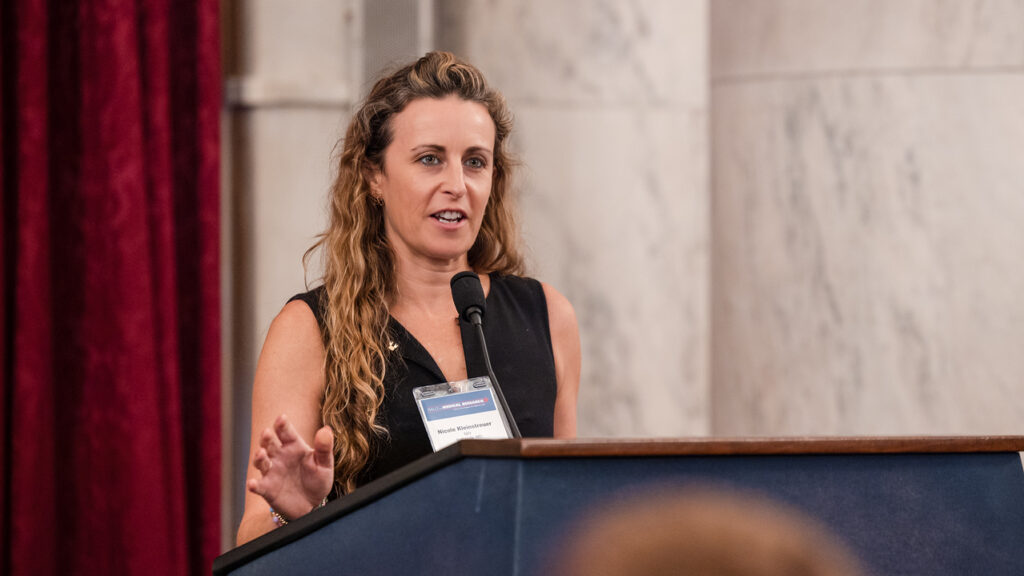
It wasn’t just a favorite childhood pet, or the fact that she cares deeply for animals, that led Nicole Kleinstreuer to help launch the National Institutes of Health’s initiative to scale back reliance on animals in research. It was also her love of numbers.
As a student, Kleinstreuer was a self-described math nerd, intrigued by the ability of mathematical models to represent the physical world. After earning degrees in applied mathematics and biomedical engineering, she went to the Environmental Protection Agency in 2009 for a post-doctoral fellowship in the then-nascent field of computational toxicology. Researchers in this area use data and models to predict whether, and at what doses, chemicals might affect human health.
Advertisement
It was during this time, Kleinstreuer recently told STAT, that she first began to think about the use of animals in biomedical research. Some animal-based toxicological methods hadn’t changed for decades. Their shortcomings, she believed, were likely contributing to the high failure rate of experimental medicines as they moved out of the lab and into human clinical trials. “And so I thought, there clearly is a better way,” she said.
This thinking mirrored the broader zeitgeist. In 2007, the National Academies had issued a major report calling on toxicologists to develop and embrace new methods that might ultimately make research faster, cheaper, and less dependent on animals. Getting to that point, however, would require many years of research, the report cautioned, as well as “substantial funding.”
Kleinstreuer has devoted her career to that effort, and in April, she was appointed acting deputy director for program coordination, planning, and strategic initiatives at NIH. In that role, she is now overseeing the creation of an office devoted to advancing such new methods: the Office of Research, Innovation, Validation, and Application, which will be led by NIH toxicologist Warren Casey.
Advertisement
The specifics are still pending approval from the Department of Health and Human Services, said Kleinstreuer, but the plan is for the new office to have two divisions, one developing and encouraging the adoption of new methods in extramural research done by academics, and the other supporting government agencies, including the Food and Drug Administration, seeking to broaden their use of new approaches.
What to call these approaches is still up for debate. They’re sometimes referred to as “new approach methodologies,” or NAMs. Others use the acronym to stand for “non-animal methodologies.”
“Novel alternative methods. Just pick your poison,” Kleinstreuer quipped in an interview.
ORIVA’s funding will depend upon the new budget, now caught up in the government shutdown. In the meantime, the NIH announced last week an $87-million effort to support the development of one type of new methodology called organoids: miniature cell cultures designed to mimic human organs.
Some scientists told STAT they worry the pivot away from animal research is premature, while other critics believe Kleinstreuer isn’t moving fast enough. Shortly after her appointment, she went on a radio show and said NIH isn’t going to phase out animal studies overnight. As innocuous as that sounded to many, she was soon aggressively targeted by an activist group opposed to government spending on animal research, and by political influencer and President Trump ally Laura Loomer, who accused Kleinstreuer of, among other things, being an “Obama-era bureaucrat” who is “perpetuating taxpayer-funded animal torture.”
This interview has been edited for length and clarity. STAT spoke with Kleinstreuer on two different days, and the order of the questions has been adjusted for clarity.
NAMs can stand for a range of phrasings. I spoke with a researcher who strongly prefers “new approach methodologies” because it emphasizes that the dominant goal is better science, whether it comes from computers and organoids, or from zebrafish and improved rodent models. Do you have thoughts on this?
Advertisement
I also tend to favor “new approach methodologies.” It’s the most all-encompassing and the most flexible definition. But because so many people use the term “alternatives” — the word is inextricably linked with NAMs — I would like to see us evolve towards flipping the decision process 180 degrees. What I mean by that: I would like for, say, within five years, animal models to be the alternatives instead of the other way around.
I would love for us to advance the science so dramatically and so comprehensively and build out this amazing toolbox of technologies and cutting-edge approaches such that researchers when they’re thinking about answering complicated questions about human health and disease, their immediate thought is, “How can I combine complex human cell-based systems with computational systems, biology models, with digital twins, with real-world agentic networks laid over large-scale multivariate longitudinal data sets to bring human-based technologies together in an integrated fashion to answer this complex question?
“And then, if I’m not getting everything I need from those technologies, how can I supplement with an animal model if it’s absolutely necessary?” That’s not the way that people go about designing their research proposals right now, by and large.
Are there certain kinds of questions or areas of disease for which it could be particularly tricky to develop NAMs?
We ask this question a lot. The answer that we get is neuroscience, always, first and foremost. [And also] infectious disease; very complex multifactorial diseases with complicated etiology, like cancer; embryonic and fetal development — anything that is dependent on massively complex multiscale whole-body interactions and timescale interactions.
But to flip it on its head: Those are the areas that we should be investing in because those are also the areas where human biology is unique.
Are there disease areas for which we might see relatively fast development and validation of NAMs?
Advertisement
I do think there’s incredible advances being made very, very rapidly in neuroscience, particularly in the development of brain organoid models. I was at the World Congress on Alternatives and Animal Use in the Life Sciences in Brazil a couple weeks ago. I chaired a session, and one of the speakers in my session, Dr. Lena Smirnova from Johns Hopkins University, is working with very complex brain organoid models that can learn how to play video games.
Oh my gosh, really? Brain organoids are so weird and fascinating.
Yep, and she’s doing incredible work in understanding the susceptibility of the developing brain to things like environmental chemical exposures and understanding mechanistic insights into neurodegenerative diseases and neurodevelopmental disorders. Part of it is understanding impact on learning and memory.
To be able to understand that, you have to demonstrate that your system can recapitulate those biological functions. So they have trained the brain organoids to learn how to play video games, like the old school Mario Brothers, where it’s running and then jumping and then running and then jumping. [The organoids] don’t have long term memory. They don’t remember the next day how to play that video game, but they have short-term memory that they iteratively improve within a session based on an electrical stimulus feedback loop.
In July, the NIH issued a new policy aimed at prioritizing the use of new approach methodologies. Can you explain it?
We are [no longer] issuing animal-specific solicitations. I’ll give you an example. We used to put out funding opportunities that were literally called “improved mouse models of disease X” — of aging, or cardiovascular disease, or whatever. And the only proposals that would be considered under that funding opportunity were mouse models. I ask you, why would you ever confine yourself to one specific model type? So those funding opportunities will now be “improved models of disease X.” Researchers are welcome to submit whatever model system they deem most appropriate to answer that question around human biology and disease.
Advertisement
I will say that we have been very clear about the fact that we are prioritizing human-based models for biomedical research. It is a reasonable expectation that well thought-out proposals that are fundamentally rooted in human biology will be more favorably scored and awarded than those that stick with historical methods that only rely on animals.
I’m wondering if you could talk about the response of animal rights supporters to the NIH’s recent initiatives. Science magazine reported that you’ve been the subject of threatening comments, which triggered security protection for you and your family.
All true.
The response in the animal rights community has been largely very positive, particularly for groups that are supportive of science: So, groups that understand the need to continue scientific progress and biomedical research to improve human health and our understanding of human disease pathways and our public health protection — they recognize that I have dedicated my entire career to advancing the science of innovative technologies and non-animal models, and doing so in a way that is strategic, thoughtful, long-lasting, and sustainable.
Those groups include the Physicians Committee for Responsible Medicine, Humane World for Animals, the PETA Science Consortium International, and many others.
You are a longtime civil servant, and the new NIH Director Jay Bhattacharya was a prominent critic of government science agencies during the Covid pandemic. In an NIH podcast, you two seemed to have a good rapport. What’s the basis for your working relationship, and how involved is he with ORIVA?
I met Jay several years ago at Stanford. I used to be on the board of a program that is part of the medical school at Stanford, and I lectured on innovative approaches to understanding drug safety. A mutual colleague introduced Jay and me. He has such a strong scientific curiosity, and he’s such a humble person. He was really immediately fascinated by the field that I was coming from.
Advertisement
I told him, I haven’t been subject to the same level of persecution as you have for standing up for your beliefs and freedom of expression, but I can at least empathize a little bit with being a disruptive force and being a change-maker. Because, as you can imagine, leading the charge to advance the use of non-animal models is not always a popular opinion in a research ecosystem that’s the largest funder of biomedical research in the world and relies predominantly on animal models. There’s, I think, a lot of pushback, and a lot of people feeling threatened that I am just going to try and come in and take all of their resources away from them — which I have never said I was doing.
I found him to be a very thoughtful, intelligent, and kind person. So we stayed in touch over the last couple years. And then when he was confirmed as the NIH director, his team reached out and said, we’d really like for you to become part of the leadership of NIH and help us advance the science and the prioritization of innovative and cutting-edge approaches.
Do you know yet how much funding the NIH will be directing to ORIVA?
No, I can’t answer that yet. All of our funding is dependent on the appropriations that we get from Congress.
What kinds of changes are you hoping ORIVA will be able to support over the next, say, five years?
I envision that ORIVA will be a strong partner to all of the NIH institutes and centers, most of which are already doing transformative work in alternatives to animal models. But the existence of ORIVA will help coordinate and accelerate that — and ensure that all of the work that’s being done is not being done in individual silos, but is being done with a cross-agency awareness and collaborative approach.
[The extramural division] will co-fund grants and programs that are initiated and managed out of the different institutes and centers. A good example: The National Center for Advancing Translational Sciences has this really great program … which is basically validation centers for tissue chips. So, maybe they get lots of outstanding applications, but because of their budget, they can only fund four of them. Then maybe [ORIVA] steps up and funds the next two so that we can get more investment in that space and make advances more rapidly.
Advertisement
Then the last piece is also looking at an extramural focus: working to ensure that experts on alternative methods are really well-represented in study sections and special emphasis panels and that we really increase that knowledge base amongst grant reviewers.



